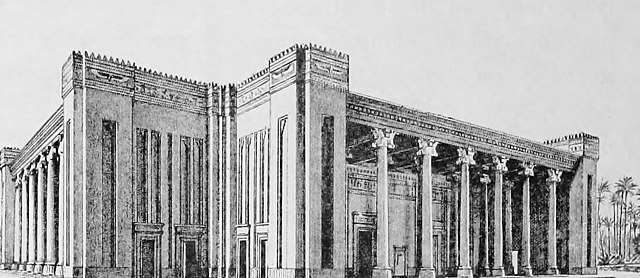Susa: Difference between revisions - Wikipedia
 Article Images
Article Images
Content deleted Content added
Tags: Reverted Visual edit Mobile edit Mobile web edit |
RodRabelo7 109,419 edits m |
||
| (5 intermediate revisions by 5 users not shown) | |||
Line 27: |builder = |material = |built = 4200 |abandoned = 1218 |epochs = <!-- actually displays as "Periods" --> |cultures = Line 47: | criteria = Cultural: i, ii, iii, iv}} }} '''Susa''' ({{IPAc-en|ˈ|s|uː|s|ə}} {{respell|SOO|sə}}; Middle {{lang-elx|𒀸𒋗𒊺𒂗|translit=Šušen}};{{sfn|Hinz|Koch|1987|page=[https://archive.org/details/ElamischesWorterbuch.2/page/n449/mode/2up 1184]}} Middle and Neo-{{lang-elx|𒋢𒋢𒌦|translit=Šušun}};{{sfn|Hinz|Koch|1987|page=[https://archive.org/details/ElamischesWorterbuch.2/page/n449/mode/2up 1184]}} Neo-[[Elamite language|Elamite]] and [[Achaemenid Empire|Achaemenid]] {{lang-elx|𒀸𒋗𒐼𒀭|translit=Šušan}};{{sfn|Hinz|Koch|1987|page=[https://archive.org/details/ElamischesWorterbuch.2/page/n449/mode/2up 1183]}} [[Achaemenid Empire|Achaemenid]] {{lang-elx|𒀸𒋗𒐼|translit=Šuša}};{{sfn|Hinz|Koch|1987|page=[https://archive.org/details/ElamischesWorterbuch.2/page/n449/mode/2up 1183]}} {{lang-fa|شوش}} {{transliteration|fa|Šuš}} {{IPA The site currently consists of three archaeological mounds, covering an area of around {{convert|1|sqkm|sqmi}}.<ref>{{cite book|author1=John Curtis|editor1-last=Perrot|editor1-first=Jean|editor1-link=Jean Perrot|title=The Palace of Darius at Susa: The Great Royal Residence of Achaemenid Persia|date=2013|publisher=I.B.Tauris|isbn=9781848856219|page=xvi|chapter-url=https://books.google.com/books?id=fDimj7F2VVgC&q=Shush+Susa&pg=PR16|language=en|chapter=Introduction}}</ref> The city of [[Shush, Iran|Shush]] is located on the site of ancient Susa. Line 97: In [[urban history]], Susa is one of the oldest-known settlements of the region. Based on calibrated [[carbon-14 dating]], the foundation of a settlement there occurred as early as 4395 BC.<ref>Potts: ''Elam'', pp. 46.</ref> In the region around Susa were a number of towns (with their own platforms) and villages that maintained a trading relationship with the city, especially those along the Zagro frontier.<ref>Wright, Henry T., "The Zagros Frontiers of Susa during the Late 5th Millennium", Paléorient, vol. 36, no. 1, pp. 11–21, 2010</ref> The founding of Susa corresponded with the abandonment of nearby villages. Potts suggests that the settlement may have been founded to try to reestablish the previously destroyed settlement at [[Chogha Mish]], about 25 km to the west.<ref name="Potts: Elam">Potts: ''Elam''.</ref> Previously, [[Chogha Mish]] was a very large settlement, and it featured a similar massive platform that was later built at Susa.<ref name=":1">{{ Another important settlement in the area is [[Chogha Bonut]], which was discovered in 1976. === Susa I period (4200–3800 BC) === Line 200: ====Middle Elamite period (c. 1500–1100 BC)==== [[File:Susa, Middle-Elamite basrelief of warrior gods 1600-1100 BCE.jpg|thumb|Middle-Elamite basrelief of warrior gods, Susa, Around 1500 BC, the Middle Elamite period began with the rise of the Anshanite dynasties. Their rule was characterized by an "Elamisation" of Susa, and the kings took the title "king of Anshan and Susa". While, previously, the Akkadian language was frequently used in inscriptions, the succeeding kings, such as the Igihalkid dynasty of c. 1400 BC, tried to use Elamite. Thus, Elamite language and culture grew in importance in Susiana.{{fact|date=January 2024}} Line 244: Events mentioned in the [[Old Testament]] book of [[Esther]] are said to have occurred in Susa during the Achaemenid period. The King [[Ahasuerus]] mentioned in that book may refer to [[Xerxes I]] (486-465 BC). === [[File:The weddings at Susa, Alexander to Stateira and Hephaistion to Drypetis (late 19th century engraving).jpg|thumb|right|250px|The marriages of [[Stateira II]] to [[Alexander the Great]] of Susa lost much of its importance after the invasion of [[Alexander the Great|Alexander the Great of Macedon]] The city retained its importance under the The city was named '''Seleucia on the Eulaeus''' or '''Seleucia ad Eulaeum'''. [[Seleucus I Nicator]] minted coins there in substantial quantities.<ref>{{cite journal |last1=Marest-Caffey |first1=Laure |title=Seleukos I's Victory Coinage of Susa Revisited: A Die Study and Commentary |journal=American Journal of Numismatics |date=2016 |volume=28 |pages=1–63}}</ref> Susa is rich in Greek inscriptions,{{Citation needed|date=May 2019}} perhaps indicating a significant number of Greeks living in the city. Especially in the royal city large, well-equipped peristyle houses have been excavated. === Parthian period === | |||